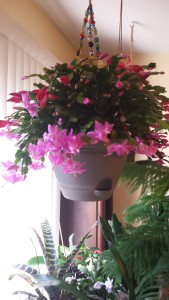Christmas cactus (Schlumbergera bridgesii) or Thanksgiving cacti (Schlumbergera truncata) are called holiday cacti. They are actually succulents and not true cacti. Both originate from tropical regions and make dependable, long-lived house plants.
Christmas cactus are frequently mislabeled as such and are really Thanksgiving cactus. Christmas cacti have flattened leaves with rounded leaf edges compared to Thanksgiving cactus that has pointed teeth.
Holiday cacti are short day plants. They bloom when night hours are 14 hours or longer and daylight hours are 8-10 hours long over 6 consecutive weeks. Bright outdoor lights or room lights may sometimes disrupt the dark period enough that they will not initiate floral buds. In such cases, plants may need to be covered (blackened) or moved into a closet each night.
An alternative method to induce flowering is to expose plants to cool 50-55°F temps. In warm areas in the Southern U.S. and other parts of the world, flowers may not form if night temperatures remain above 68°F regardless of daylength.
Holiday cacti should be repotted annually, preferably in February or March. Water only when potting soil feels dry or once weekly. Mist plants if the room humidity is low. Some flower buds may drop prematurely if room humidity is low or plant is open to cold air drafts. Ideal room temps are 70°F or higher daytime and 55 – 65°F at night. After threat of spring frost has ended, move holiday cacti outdoors into a partly shaded area. Continue to water and feed plants through the summer months.
Mix water soluble fertilizer products such as Miracle-Gro™, Hyponex™, or Espoma™ at one-half the package rate. Withhold winter feeding of plants until most flowers have dropped or restart in late February.
Mealy bugs and soft shell scales are potential problem pests. Overwatering leads to stem and root rots. Plant(s) may be pruned anytime for shaping. Old plants with dead or unattractive branches may be severely cutback after repotting in the spring. Such plants quickly recover.



 Posted in
Posted in 
